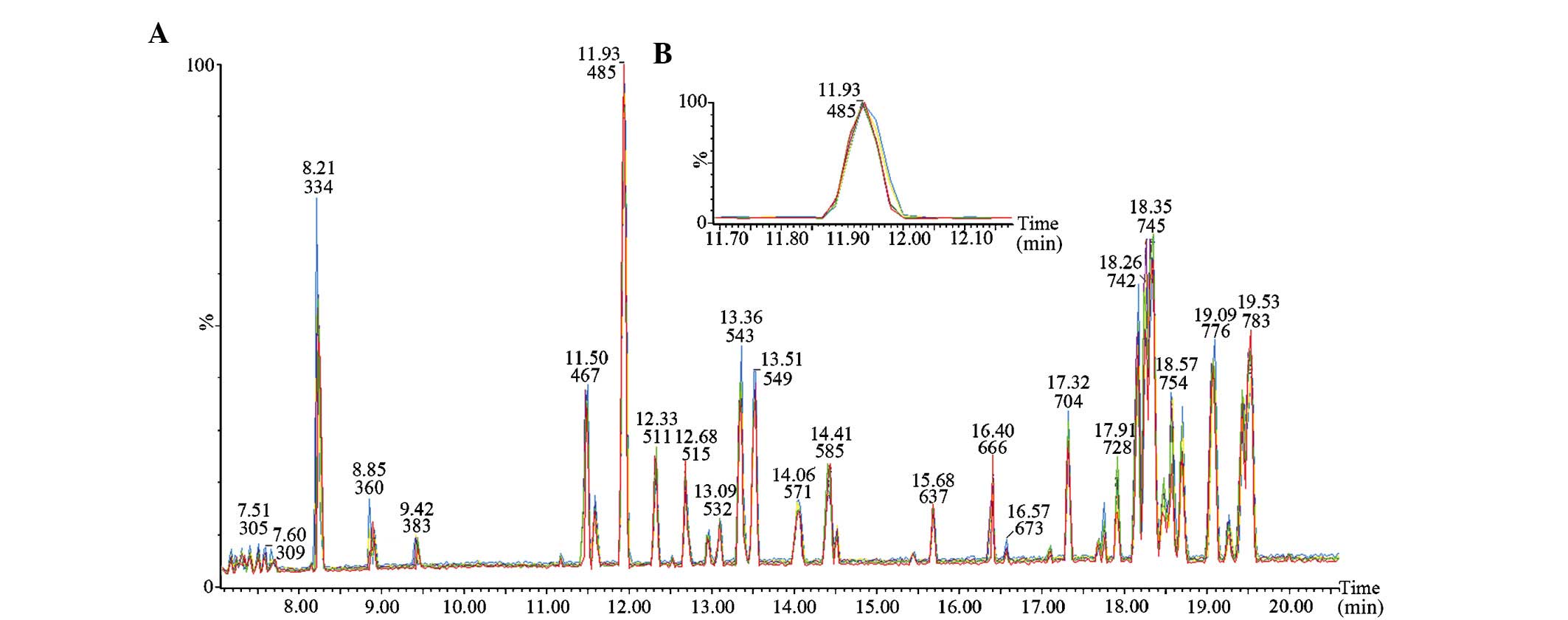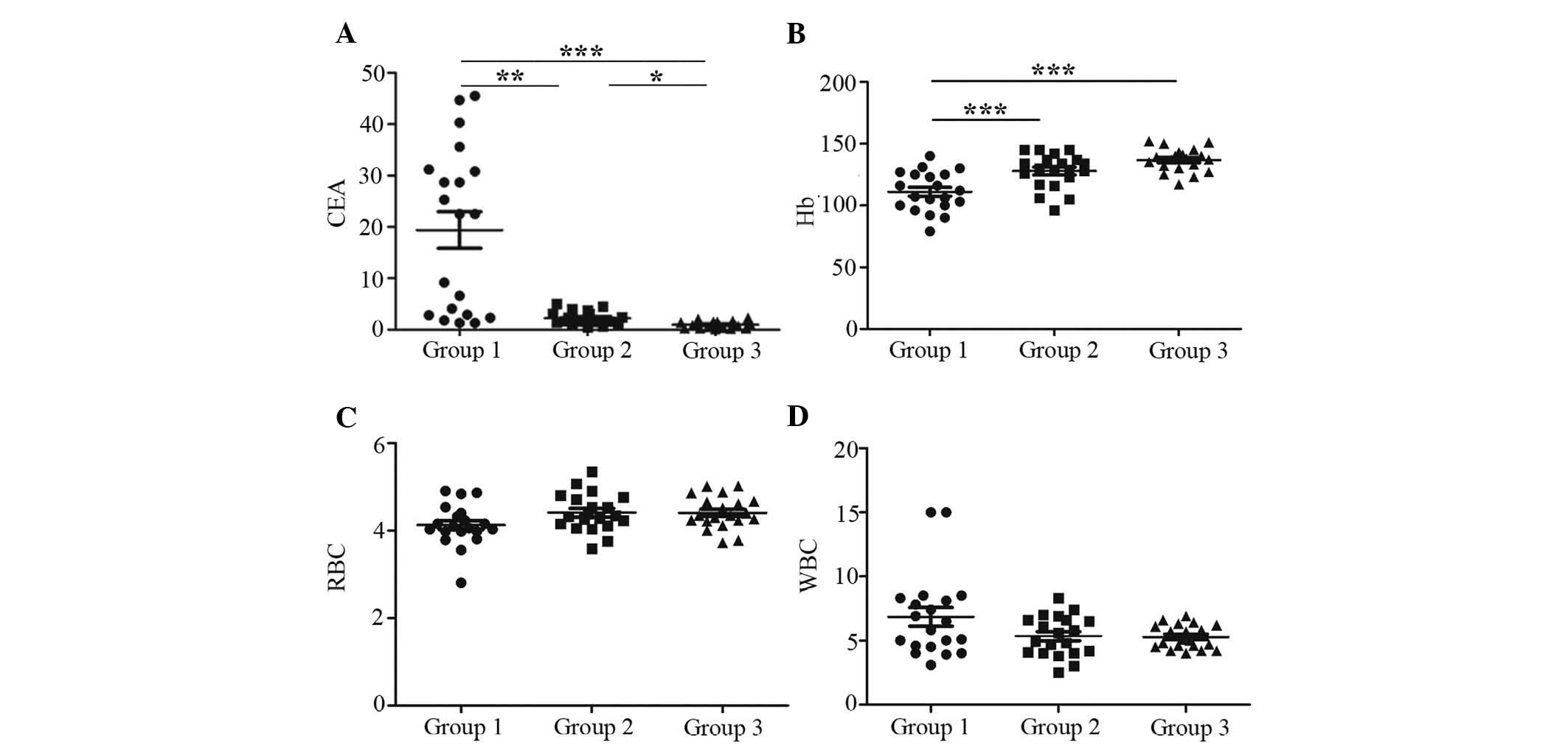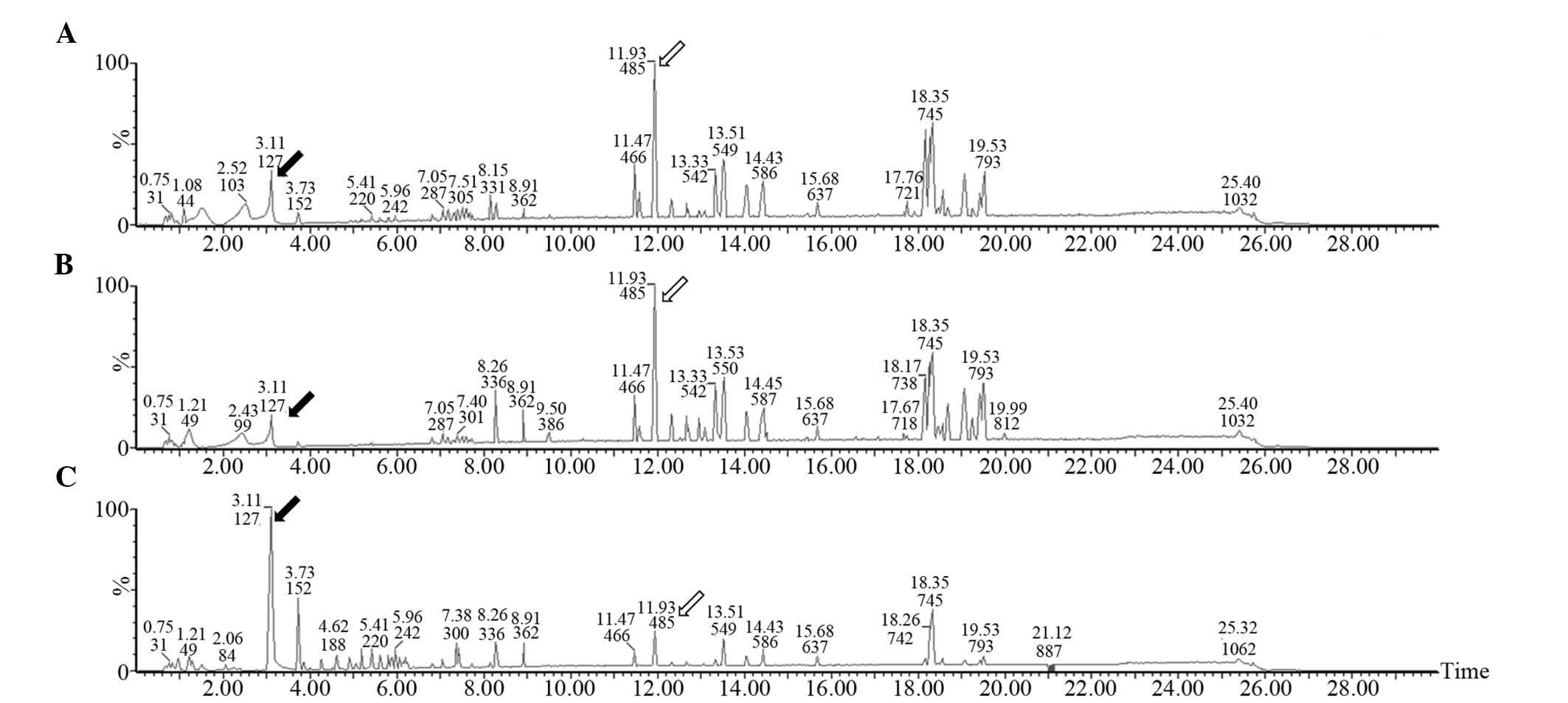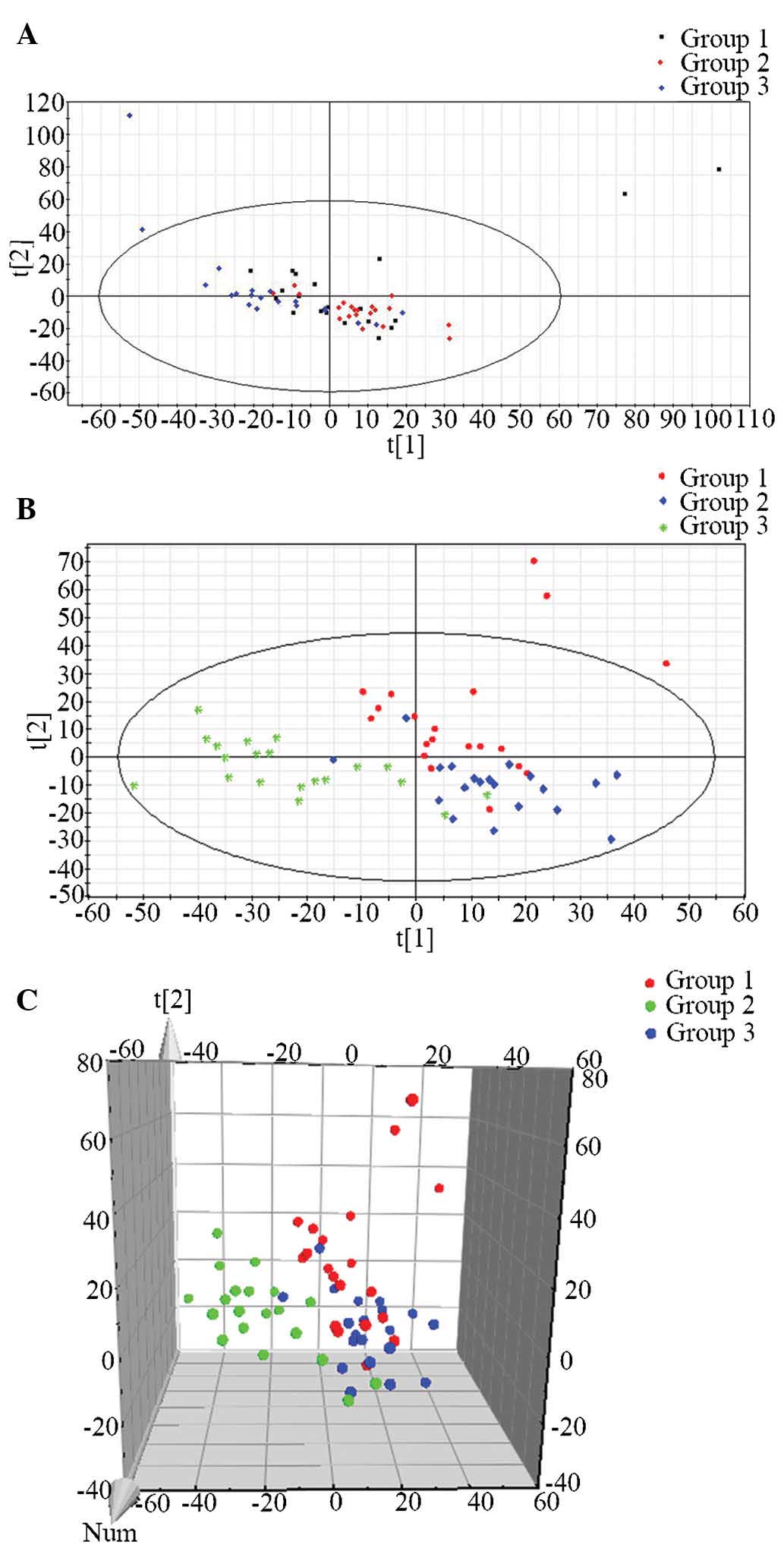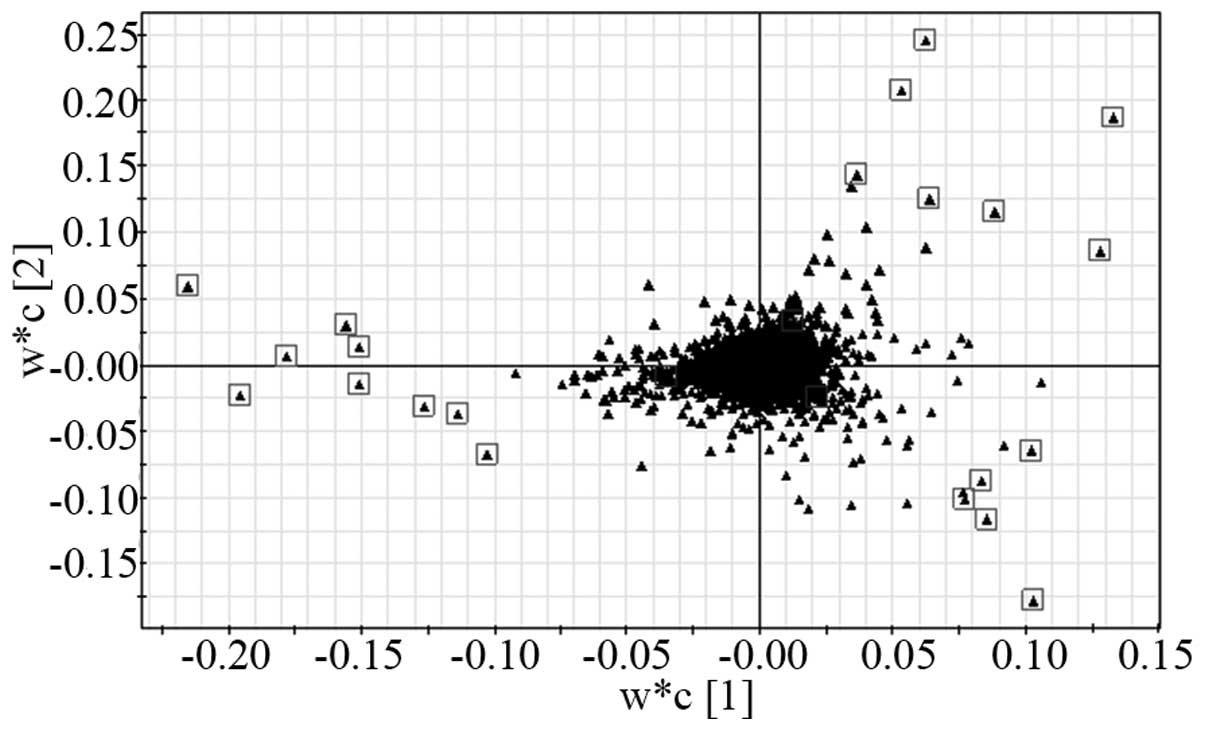|
1
|
Sideris M and Papagrigoriadis S: Molecular
biomarkers and classification models in the evaluation of the
prognosis of colorectal cancer. Anticancer Res. 34:2061–2068.
2014.PubMed/NCBI
|
|
2
|
Zhang A, Sun H, Yan G, Wang P, Han Y and
Wang X: Metabolomics in diagnosis and biomarker discovery of
colorectal cancer. Cancer Lett. 345:17–20. 2014. View Article : Google Scholar
|
|
3
|
Møller Sørensen N, Vejgaard Sørensen I,
Ørnbjerg Würtz S, Schrohl AS, Dowell B, Davis G, Jarle Christensen
I, Nielsen HJ and Brünner N: Biology and potential clinical
implications of tissue inhibitor of metalloproteinases-1 in
colorectal cancer treatment. Scand J Gastroenterol. 43:774–786.
2008. View Article : Google Scholar : PubMed/NCBI
|
|
4
|
Berkovich L, Shpitz B, Ghinea R, Greemland
I, Kravtsov V, Kidron D, Mishaeli M and Avital S: Evaluation of
peritoneal CEA levels following colorectal cancer surgery. J Surg
Oncol. 110:458–462. 2014. View Article : Google Scholar : PubMed/NCBI
|
|
5
|
Goedert JJ, Sampson JN, Moore SC, Xiao Q,
Xiong X, Hayes RB, Ahn J, Shi J and Sinha R: Fecal metabolomics:
Assay performance and association with colorectal cancer.
Carcinogenesis. 35:2089–2096. 2014. View Article : Google Scholar : PubMed/NCBI
|
|
6
|
Griffin JL and Bollard ME: Metabonomics:
Its potential as a tool in toxicology for safety assessment and
data integration. Curr Drug Metab. 5:389–398. 2004. View Article : Google Scholar : PubMed/NCBI
|
|
7
|
Wu T, Xie G, Ni Y, Liu T, Yang M, Wei H,
Jia W and Ji G: Serum metabolite signatures of type 2 diabetes
mellitus complications. J Proteome Res. 14:447–456. 2015.
View Article : Google Scholar
|
|
8
|
Chan AW, Gill RS, Schiller D and Sawyer
MB: Potential role of metabolomics in diagnosis and surveillance of
gastric cancer. World J Gastroenterol. 20:12874–12882. 2014.
View Article : Google Scholar : PubMed/NCBI
|
|
9
|
Zhao L, Wan L, Qiu X, Li R, Liu S and Wang
D: A metabonomics profiling study on phlegm syndrome and
blood-stasis syndrome in coronary heart disease patients using
liquid chromatography/quadrupole time-of-flight mass spectrometry.
Evid Based Complement Alternat Med. 2014:3851022014. View Article : Google Scholar : PubMed/NCBI
|
|
10
|
Fanos V, Pintus MC, Lussu M, Atzori L,
Noto A, Stronati M, Guimaraes H, Marcialis MA, Rocha G, Moretti C,
et al: Urinary metabolomics of bronchopulmonary dysplasia (BPD):
Preliminary data at birth suggest it is a congenital disease. J
Matern Fetal Neonatal Med. 27(Suppl 2): 39–45. 2014. View Article : Google Scholar : PubMed/NCBI
|
|
11
|
Ma YL, Qin HL, Liu WJ, Peng JY, Huang L,
Zhao XP and Cheng YY: Ultra-high performance liquid
chromatography-mass spectrometry for the metabolomic analysis of
urine in colorectal cancer. Dig Dis Sci. 54:2655–2662. 2009.
View Article : Google Scholar : PubMed/NCBI
|
|
12
|
Wilson ID, Nicholson JK, Castro-Perez J,
Granger JH, Johnson KA, Smith BW and Plumb RS: High resolution
'ultra performance' liquid chromatography coupled to oa-TOF mass
spectrometry as a tool for differential metabolic pathway profiling
in functional genomic studies. J Proteome Res. 4:591–598. 2005.
View Article : Google Scholar : PubMed/NCBI
|
|
13
|
Akkoca AN, Yanık S, Ozdemir ZT, Cihan FG,
Sayar S, Cincin TG, Cam A and Ozer C: TNM and modified Dukes
staging along with the demographic characteristics of patients with
colorectal carcinoma. Int J Clin Exp Med. 7:2828–2835.
2014.PubMed/NCBI
|
|
14
|
Fuhrer T and Zamboni N: High-throughput
discovery metabolomics. Curr Opin Biotechnol. 31:73–78. 2015.
View Article : Google Scholar
|
|
15
|
Tsakanova GV, Ayvazyan VA, Boyajyan AS,
Arakelova EA, Grigoryan GS, Guevorkyan AA and Mamikonyan AA: A
comparative study of antioxidant system and intensity of lipid
peroxidation in type 2 diabetes mellitus and ischemic stroke
aggravated and not aggravated by type 2 diabetes mellitus. Bull Exp
Biol Med. 151:564–566. 2011. View Article : Google Scholar
|
|
16
|
Balci H, Genc H, Papila C, Can G, Papila
B, Yanardag H and Uzun H: Serum lipid hydroperoxide levels and
paraoxonase activity in patients with lung, breast and colorectal
cancer. J Clin Lab Anal. 26:155–160. 2012. View Article : Google Scholar : PubMed/NCBI
|
|
17
|
Navarro-Compán V, Melguizo-Madrid E,
Hernández-Cruz B, Santos-Rey K, Leyva-Prado C, González-Martín C,
Navarro-Sarabia F and González-Rodríguez C: Interaction between
oxidative stress and smoking is associated with an increased risk
of rheumatoid arthritis: A case-control study. Rheumatology
(Oxford). 52:487–493. 2013. View Article : Google Scholar
|
|
18
|
Shindou H, Hishikawa D, Harayama T, Yuki K
and Shimizu T: Recent progress on acyl CoA: Lysophospholipid
acyltransferase research. J Lipid Res. 50(Suppl): S46–S51. 2009.
View Article : Google Scholar :
|
|
19
|
Baltaziak M, Wincewicz A, Kanczuga-Koda L,
Lotowska JM, Koda M, Sulkowska U, Baltaziak M, Podbielski M,
Sobaniec-Lotowska ME and Sulkowski S: The relationships between
hypoxia-dependent markers: HIF-1alpha, EPO and EPOR in colorectal
cancer. Folia Histochem Cytobiol. 51:320–325. 2013. View Article : Google Scholar
|
|
20
|
Zhang J, Cao J, Ma S, Dong R, Meng W, Ying
M, Weng Q, Chen Z, Ma J, Fang Q, et al: Tumor hypoxia enhances
non-small cell lung cancer metastasis by selectively promoting
macrophage M2 polarization through the activation of ERK signaling.
Oncotarget. 5:9664–9677. 2014. View Article : Google Scholar : PubMed/NCBI
|
|
21
|
Lu Y, Lin N, Chen Z and Xu R:
Hypoxia-induced secretion of platelet-derived growth factorBB by
hepatocellular carcinoma cells increases activated hepatic stellate
cell proliferation, migration and expression of vascular
endothelial growth factor A. Mol Med Rep. 11:691–697. 2015.
|
|
22
|
Granchi C, Fancelli D and Minutolo F: An
update on therapeutic opportunities offered by cancer glycolytic
metabolism. Bioorg Med Chem Lett. 24:4915–4925. 2014. View Article : Google Scholar : PubMed/NCBI
|
|
23
|
Catalá A: Lipid peroxidation of membrane
phospholipids generates hydroxy-alkenals and oxidized phospholipids
active in physiological and/or pathological conditions. Chem Phys
Lipids. 157:1–11. 2009. View Article : Google Scholar
|
|
24
|
Sugiyama A and Sun J: Immunochemical
detection of lipid hydroperoxide- and aldehyde-modified proteins in
diseases. Subcell Biochem. 77:115–125. 2014. View Article : Google Scholar : PubMed/NCBI
|
|
25
|
Yoo MH, Gu X, Xu XM, Kim JY, Carlson BA,
Patterson AD, Cai H, Gladyshev VN and Hatfield DL: Delineating the
role of glutathione peroxidase 4 in protecting cells against lipid
hydroperoxide damage and in Alzheimer's disease. Antioxid Redox
Signal. 12:819–827. 2009. View Article : Google Scholar : PubMed/NCBI
|
|
26
|
Ganesan K, Ivanova T, Wu Y, Rajasegaran V,
Wu J, Lee MH, Yu K, Rha SY, Chung HC, Ylstra B, et al: Inhibition
of gastric cancer invasion and metastasis by PLA2G2A, a novel
beta-catenin/TCF target gene. Cancer Res. 68:4277–4286. 2008.
View Article : Google Scholar : PubMed/NCBI
|
|
27
|
Fijneman RJ, Peham JR, van de Wiel MA,
Meijer GA, Matise I, Velcich A and Cormier RT: Expression of
Pla2g2a prevents carcinogenesis in Muc2-deficient mice. Cancer Sci.
99:2113–2119. 2008. View Article : Google Scholar : PubMed/NCBI
|
|
28
|
Avoranta T, Sundström J, Korkeila E,
Syrjänen K, Pyrhönen S and Laine J: The expression and distribution
of group IIA phospholipase A2 in human colorectal tumours. Virchows
Arch. 457:659–667. 2010. View Article : Google Scholar : PubMed/NCBI
|
|
29
|
Ma J, Yu J, Su X, Zhu C, Yang X, Sun H,
Chen D, Wang Y, Cao H and Lu J: UPLC-MS-based serum metabonomics
for identifying acute liver injury biomarkers in Chinese miniature
pigs. Toxicol Lett. 225:358–366. 2014. View Article : Google Scholar : PubMed/NCBI
|
|
30
|
Nankar SA, Prajapati JS and Pande AH:
Apolipoprotein E derived peptides inhibit the pro-inflammatory
effect of lysophosphatidylcholine. Protein Pept Lett. 21:101–107.
2014. View Article : Google Scholar
|
|
31
|
Bassa BV, Noh JW, Ganji SH, Shin MK, Roh
DD and Kamanna VS: Lysophosphatidylcholine stimulates EGF receptor
activation and mesangial cell proliferation: Regulatory role of Src
and PKC. Biochim Biophys Acta. 1771:1364–1371. 2007. View Article : Google Scholar : PubMed/NCBI
|
|
32
|
Kuliszkiewicz-Janus M, Tuz MA and
Baczyński S: Application of 31P MRS to the analysis of phospholipid
changes in plasma of patients with acute leukemia. Biochim Biophys
Acta. 1737:11–15. 2005. View Article : Google Scholar : PubMed/NCBI
|
|
33
|
Taylor LA, Arends J, Hodina AK, Unger C
and Massing U: Plasma lyso-phosphatidylcholine concentration is
decreased in cancer patients with weight loss and activated
inflammatory status. Lipids Health Dis. 6:172007. View Article : Google Scholar : PubMed/NCBI
|
|
34
|
Süllentrop F, Moka D, Neubauer S, Haupt G,
Engelmann U, Hahn J and Schicha H: 31P NMR spectroscopy of blood
plasma: Determination and quantification of phospholipid classes in
patients with renal cell carcinoma. NMR Biomed. 15:60–68. 2002.
View Article : Google Scholar : PubMed/NCBI
|
|
35
|
Umezu-Goto M, Tanyi J, Lahad J, Liu S, Yu
S, Lapushin R, Hasegawa Y, Lu Y, Trost R, Bevers T, et al:
Lysophosphatidic acid production and action: Validated targets in
cancer? J Cell Biochem. 92:1115–1140. 2004. View Article : Google Scholar : PubMed/NCBI
|
|
36
|
Poli A, Mongiorgi S, Cocco L and Follo MY:
Protein kinase C involvement in cell cycle modulation. Biochem Soc
Trans. 42:1471–1476. 2014. View Article : Google Scholar : PubMed/NCBI
|
|
37
|
Poli A, Ramazzotti G, Matteucci A, Manzoli
L, Lonetti A, Suh PG, McCubrey JA and Cocco L: A novel
DAG-dependent mechanism links PKCa and Cyclin B1 regulating cell
cycle progression. Oncotarget. 5:11526–11540. 2014. View Article : Google Scholar : PubMed/NCBI
|
|
38
|
Domart MC, Hobday TM, Peddie CJ, Chung GH,
Wang A, Yeh K, Jethwa N, Zhang Q, Wakelam MJ, Woscholski R, et al:
Acute manipulation of diacylglycerol reveals roles in nuclear
envelope assembly & endoplasmic reticulum morphology. PLoS One.
7:e511502012. View Article : Google Scholar :
|



